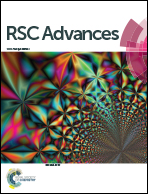The efficient biogeneration of Ag and NiO nanoparticles from VPLE and a study of the anti-diabetic properties of the extract
Abstract
Vitex pseudo-negundo leaf extract (VPLE) is used to mediate the green biosynthesis of Ag and NiO nanoparticles in aqueous solutions under mild conditions. The synthesized nanoparticles, with a narrow size range and good distribution, are characterized by means of powder X-ray diffraction (PXRD), Fourier-transform infrared (FT-IR), scanning electron microscopy (SEM), energy-dispersive X-ray spectroscopy (EDX), and transmission electron microscopy (TEM) techniques. SEM and TEM micrographs proved formation of mostly spherical or ellipsoidal nanoparticles with little agglomeration, and the average particle size was less than 20–35 nm for both types of nanoparticle. Then, the protective role of VPLE toward the liver is assessed in streptozotocin-induced diabetic rats. For this purpose, diabetes is induced in rats through the intraperitoneal injection of streptozotocin, and VPLE is administered via oral gavage for 6 weeks. This study suggests that VPLE can ameliorate biochemical and structural changes in the livers of diabetic rats, showing that VPLE can improve the condition of rats with diabetic hepatopathy via a decrease in oxidative stress and an enhancement in the activity of antioxidant enzymes in the liver.



 Please wait while we load your content...
Please wait while we load your content...